 W
WAnguilla bicolor is a species of eel in the genus Anguilla of the family Anguillidae, consisting of two subspecies.
 W
WArgyrosomus japonicus is a silvery to bronze-green colored fish, a member of the family Sciaenidae, which may grow up to 2 m in length. It is known as mulloway or jewfish on the east coast of Australia, butterfish in South Australia, kingfish or river kingfish in Western Australia, and dusky/squaretail kob, Dusky Salmon, Salmon or kabeljou in South Africa. The name jewfish refers to its large otoliths, which are prized as "jewels" by some fishers.
 W
WThe Asian arowana comprises several phenotypic varieties of freshwater fish distributed geographically across Southeast Asia. While most consider the different varieties to belong to a single species, work by Pouyaud et al. (2003) differentiates these varieties into multiple species. They have several other common names, including Asian bonytongue, dragonfish, and a number of names specific to the different color varieties.
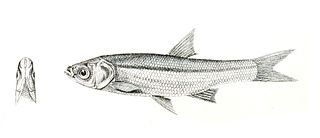 W
WThe attentive carplet or silver carplet is a species of carplet in the family Cyprinidae. It is found in freshwater streams, ponds and rivers of India and Sri Lanka.
 W
WThe banded moray, also known as the banded reef-eel, Rüppell's moray, Rüppell's moray eel, black barred eel, yellow-headed moray eel or yellow-headed moray, is a moray eel found in coral reefs in Red Sea, East Africa to Hawaii, Tuamotu, Marquesas Islands, north of Ryukyu Islands and south of the Great Barrier Reef. It is a pale grey to greyish-brown moray with a 16-21 dark bars on the body and fins that become indistinct with growth, top of the head yellow and a dark spot at the corner of the mouth.
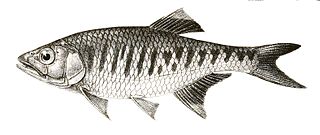 W
WBarilius gatensis is a fish in genus Barilius of the family Cyprinidae.
 W
WThe bigmouth buffalo is a fish native to North America, and it is in decline. It is the largest North American species in the Catostomidae or "sucker" family, and is one of the longest-lived and latest-maturing freshwater fishes, capable of living beyond 110 years and reproducing infrequently. It is commonly called the gourdhead, marblehead, redmouth buffalo, buffalofish, bernard buffalo, roundhead, or brown buffalo. The bigmouth buffalo is not a carp, nor is any other fish in the sucker family. Although they share the same order, each belong to different suborders and are native to separate continents.
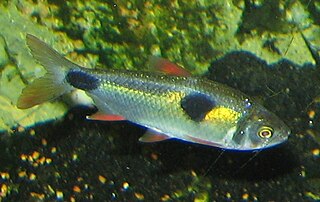 W
WThe bucktooth tetra is the only member of the genus Exodon and is a freshwater fish of the characin family of order Characiformes. It is native to the Amazon Basin and Guyana. Though first described in 1845, it was not imported and distributed by the aquarium trade until 1932.
 W
WChaetodontoplus septentrionalis, common names blue-striped angelfish and bluelined angelfish, is a species of marine fish in the family Pomacanthidae.
 W
WCirrhinus molitorella is a species of ray-finned fish in the genus Cirrhinus found mainly in southern China and Vietnam.
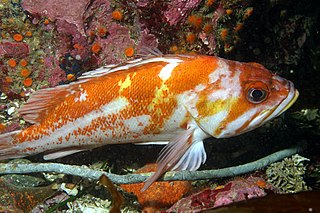 W
WThe copper rockfish, also known as the copper seaperch, is a fish of the family Sebastidae.
 W
WCtenopoma multispine, known as the many-spined ctenopoma or climbing perch, is an African freshwater fish. It is up to 14 cm (5.5 in) long and occurs in the Lufira River, Lualaba River, Upemba River, Luapula-Moero in the Democratic Republic of the Congo, Upper Zambezi in Zambia and Okavango River-Lake Ngami in Angola and Botswana. It is also known from the Kafue, rivers of coastal Mozambique, Cuanza River in Angola, and southern tributaries of the Congo River system.
 W
WDawkinsia filamentosa is a species of barb. Young fish have barely any color and black spots. They start having more color at three months old. The fish is a swift swimmer. Males are larger than females and they fertilize eggs by swimming into the cloud of eggs. The species is most commonly found in coastal floodplains near the Southwest Indian states of Kerala, Tamil Nadu and Karnataka. The species' common names are filament barb and blackspot barb.
 W
WFavonigobius lentiginosus is a species of goby native to the coastal waters of Australia and New Zealand. This species can reach a length of 6 centimetres (2.4 in) TL.
 W
WThe gilled lungfish, also known as the East African lungfish, is a species of African lungfish. It is found in the swamps and flood plains of East Africa, and has been positively identified in Kenya, Somalia and Mozambique. Records from Tanzania require confirmation and may be the result of introductions.
 W
WThe grass carp is a large herbivorous freshwater fish species of the family Cyprinidae native to eastern Asia, with an original range from northern Vietnam to the Amur River on the Siberia-China border. This Asian carp is the only species of the genus Ctenopharyngodon.
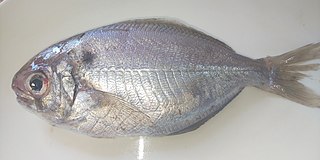 W
WThe Pacific rudderfish is a marine fish also known by such names as Japanese butterfish, melon seed, wart perch, ibodai or simply but ambiguously as butterfish.
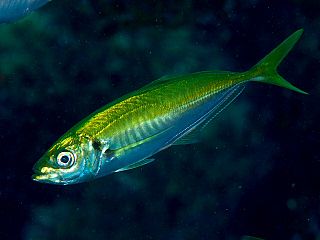 W
WThe Japanese jack mackerel, also known as the Japanese horse mackerel or Japanese scad, is a species named after its resemblance to mackerel but which is in the family Carangidae, the jacks, pompanos, trevallies and scads. Their maximum reported length is 50 cm (20 in) with a common length of 35 cm (14 in). They have a maximum reported weight of 0.66 kg (1.5 lb) and a maximum reported age of 12 years. They are found around the coast of Japan, apart from Okinawa Island, usually on sandy bottoms of 50–275 m (164–902 ft) deep. They feed mainly on small crustaceans such as copepods, and shrimps and small fish. They are similar to the yellowtail horse mackerel around New Zealand and Australia, apart from having more gill rakers and larger eyes.
 W
WThe Japanese silver-biddy is a species of mojarra native to the coastal waters of the western Pacific Ocean from southern Korea to southern Japan, though it does not occur around the Ryukyu Islands. This species can reach 22.4 cm (8.8 in) in standard length. It is commercially important for the local fish industry in Japan.
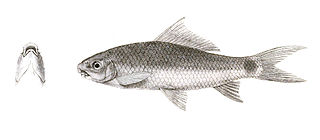 W
WLabeo porcellus is a species of fish in the family Cyprinidae, the carps and minnows. Its common name is the Bombay labeo. It is native to India.
 W
WMacrochirichthys macrochirus, the long pectoral-fin minnow or giant sword minnow, is a species of cyprinid fish found in rivers and lakes in Southeast Asia where it is used as a food fish. It is the only member of its genus. It is predatory and reaches up to 1 m (3.3 ft) in length.
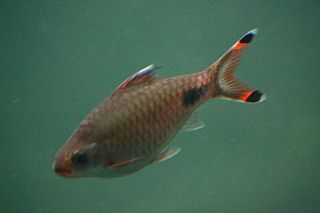 W
WThe Mahecola barb is a species of ray-finned fish in the genus Puntius. It is found in Kerala, India.
 W
WThe marbled rockcod is a species of notothen native to the Southern Ocean, where it can be found at depths from 5 to 350 m. This is a commercially important species.
 W
WMetynnis hypsauchen is a species of serrasalmid found in Amazon and Paraguay river basins, as well as rivers of the Guiana Shield. It is one of the fish known as the "silver dollar" in the aquarium trade. It has frequently been confused with the very similar M. argenteus. It reaches a length of 15 cm (5.9 in).
 W
WThe redhook myleus, Myloplus rubripinnis, is a medium to large omnivorous fish of the family Serrasalmidae from South America, where found in the Amazon and Orinoco basins, as well as rivers of the Guiana Shield. It is peaceful and schools often, and can grow to a length of 39 cm (15 in). They are also called the redhook silver dollar and are one of the fish referred to as "silver dollars". These fish are capable of delivering serious bites to humans.
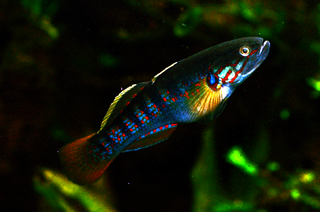 W
WMogurnda mogurnda, commonly known as the northern trout gudgeon or northern purple-spotted gudgeon is a freshwater fish native to northern Australia and New Guinea.
 W
WNotoscopelus elongatus is a species of lanternfish in the family Myctophidae. It is endemic to the Mediterranean Sea where it is found in deep water habitats, rising to near the surface to feed at night and descending to great depths by day. It is a common species with no particular threats, and the International Union for Conservation of Nature has listed its conservation status as being of least concern.
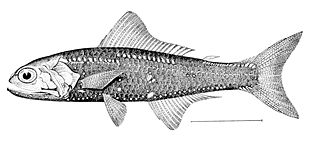 W
WNotoscopelus resplendens, commonly known as the patchwork lampfish or patchwork lanternfish, is a species of lanternfish in the family Myctophidae. It is found in the eastern and western Atlantic Ocean, the Indian Ocean and parts of the Pacific Ocean. It spends the daylight hours in deep water, rising at night to near the surface. This fish was first described by the Scottish naturalist and arctic explorer John Richardson in 1845.
 W
WNotothenia coriiceps, also known as the black rockcod, Antarctic yellowbelly rockcod, or Antarctic bullhead notothen, is a species of notothen that is widely spread around the Antarctic continent. Like other Antarctic notothenioid fishes, N. coriiceps evolved in the stable, ice-cold environment of the Southern Ocean. It is not currently targeted by commercial fisheries.
 W
WOphisternon bengalense the Bengal eel, Bengal mudeel or onegill eel, is a species of fish in the family Synbranchidae. It is endemic to freshwater and brackish water rivers and swamps in the Oceania and South Asia. It is normally 100 cm in maximum length.
 W
WOsteobrama alfredianus, the rohtee, is a species of ray-finned fish in the genus Osteobrama. It is found in the River Salween basin in south-east Asia
 W
WOsteobrama belangeri (Pengba/Belengee) is a species of ray-finned fish in the genus Osteobrama it was found in the Indian state of Manipur, but has been extirpated there and is found only in aquaculture, and in Myanmar. It is used as a food fish, from fish farms in Manipur and wild caught in Myanmar. The extirpation of this species from Manipur was caused by dam building, habitat degradation and the introduction of alien species which caused the populations to fragment.
 W
WThe Pacific bluefin tuna is a predatory species of tuna found widely in the northern Pacific Ocean, but it is migratory and also recorded as a visitor to the south Pacific.
 W
WPelasgus stymphalicus, also known as the dáska or stymphalia minnow, is a threatened species of small freshwater fish. It is a short-lived species, and reaches a maximum length of 12 cm.
 W
WPentaceros richardsoni, the pelagic armourhead, Richardson's boarfish or southern boarfish, is a species of marine ray-finned fish, an armourhead from the family Pentacerotidae. It has a wide distribution in the oceans of the southern hemisphere. It is commercially important as a food fish.
 W
WThe Chesapeake logperch is a small species of freshwater ray-finned fish, a darter from the subfamily Etheostomatinae, part of the family Percidae, which also contains the perches, ruffes and pikeperches. It is found in the Chesapeake Bay drainages. It prefers gravel runs and riffles of small to medium-sized rivers.
 W
WThe red handfish is a species of handfish in the genus Thymichthys, found in Frederick Henry Bay, Tasmania.
 W
WPataecus fronto, the Red Indianfish, is a species of Australian prowfish endemic to the coastal waters of western and southern Australia where it occurs at depths of from 40 to 80 metres. This species grows to a length of 27 centimetres (11 in) TL. This species is the only known member of its genus.
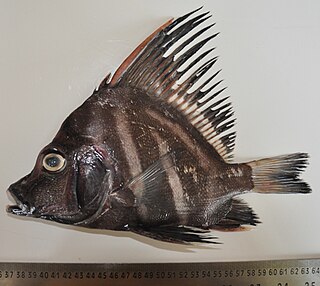 W
WThe sailfin armourhead, also known as the threebar boarfish, is a species of marine ray-finned fish, an armourhead from the family Pentacerotidae which is native to the Indian Ocean and the western Pacific Ocean. It is an inhabitant of rocky reefs in deeper waters of 40 to 421 m in depth. This species grows to a length of 42 cm (17 in), though most are only around 20 cm (7.9 in). It is a commercially important species, and is the only known member of its genus.
 W
WThe Sardinella razorbelly minnow is a species of ray-finned fish in the genus Salmostoma. It occurs in the lower reaches of rivers in India, Bangladesh and Myanmar.
 W
WThe silver razorbelly minnow Chela Maach in Bengali is a species of ray-finned fish in the carp family, Cyprinidae. It is native to India, where it occurs in many river systems. It has also been reported from Bangladesh.
 W
WThe spiny red gurnard is a species of searobin native to the northwestern Pacific Ocean where they occur at depths of from 25 to 615 metres. This species grows to a length of 40 centimetres (16 in) TL. This species is of commercial importance as a food fish.
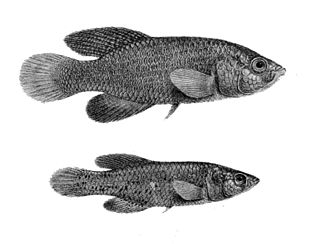 W
WThe spotted killifish is a small, short lived species of fish, an African rivuline from the family Nothobranchiidae. These fish are native to many isolated freshwater pools located in the savannah depressions of east Africa, specifically Malawi, Mozambique, Zimbabwe, and South Africa. This species of fish occurs in ephemeral waters and killifish eggs can survive long periods of dehydration. The word killifish likely comes from the Dutch kil for kill.
 W
WThe striped beakfish, also known as the barred knifejaw, is a species of marine ray-finned fish, a knifejaw from the family Oplegnathidae, It is native to the northwestern Pacific Ocean, though a smattering of records exists from other localities in the eastern Pacific such as Hawaii and Chile. It is an inhabitant of rocky reefs and occurs at depths from 1 to 10 m. Juvenile members of this species can be found with patches of drifting seaweed. This species can reach a total length of 80 cm (31 in), with the greatest recorded weight for this species of 6.4 kg (14 lb). The color pattern consists of light and dark vertical bars from which it derives its name. It has been recorded as feeding on hard-shelled invertebrates such as crustaceans and molluscs. It is a commercially important species and is also farmed. It is also sought after as a game fish.
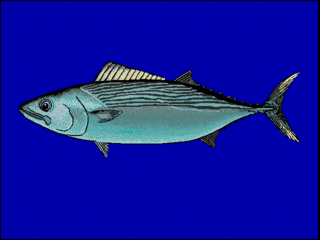 W
WThe striped bonito is a species of marine perciform fish. They have been recorded at lengths of 102 centimetres (40 in), though they are commonly no longer than 55 centimetres (22 in). Distributed through the Indo-Pacific and East Pacific, the striped bonito is known to occur at depths from 1 to 167 metres. They are called mackerel bonito.
 W
WVimba elongata is a European freshwater fish species in the family Cyprinidae. Inhabits the basin of upper Danube: alpian lakes of upper Austria and southern Bavaria.
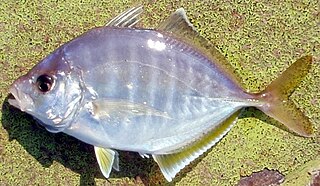 W
WThe whitefin trevally, also known as the horse trevally, is a species of deep water offshore fish in the jack family Carangidae. The species inhabits the tropical to temperate waters of the Indo-Pacific and central Pacific, ranging from South Africa in the west to Hawaii in the east. The whitefin trevally is a moderate-sized fish, growing to 37 cm, and is distinguished by a number of morphological traits, including fin size, gill raker count, and colour. It inhabits the continental shelf and slope at depths to 200 m over sand and mud substrates, where it preys on fish, crustaceans, and cephalopods. Studies in Japan indicate a length at sexual maturity of 17.4 cm on average, with spawning occurring between May and October, with each individual spawning multiple times. Whitefin trevallies are of high importance to fisheries in Japan, where they are taken by trawlers, although the catch numbers have halved since the 1980s. It is of minor importance elsewhere throughout its range, but is considered a good table fish.
 W
WThe yellowtail trumpeter, Amniataba caudavittata, is a common species of coastal marine fish of the grunter family, Terapontidae. The yellowtail trumpeter is native to Australia and Papua New Guinea, ranging from Cape Leeuwin in Western Australia along the north coast to Bowen, Queensland, and along the southern coast of Papua New Guinea.